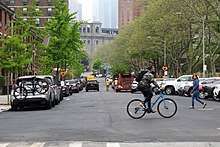Cherry Street (Manhattan)
40°42′41″N 73°59′20″W / 40.7114°N 73.9889°W




Cherry Street is a
Description
Cherry Street's eastern terminus is at the intersection of FDR Drive's southbound service road and Grand Street, where it bends right and turns into Cherry Street. It then runs west for one block, along the north edge of Corlears Hook Park, to Jackson Street. Then it is demapped for approximately two blocks, from Jackson Street to Gouvernour Street and Gouvernour Street to Montgomery Street (with the Vladeck Houses built over demapped section). It continues west, running parallel to the FDR Drive and one block north of it, for three blocks, to Pike Street/Slip. Afterward, it runs west from Pike, under the Manhattan Bridge access ramp, one block to Market Street; Cherry Street then goes one block further west, parallel to and one block north of Water Street. Cherry Street has its western terminus here, at its intersection with Catherine Street/Slip.
History
Cherry Street was originally established in colonial times to run from the intersection of Pearl Street and Frankfort Street in Lower Manhattan, approximately 1.44 miles (2.32 km) east to Grand Street in Corlear's Hook. The section between Pearl Street and Catherine Street was removed block-by-block due to development, starting with the building of the Brooklyn Bridge in the 1860s. Before various sections were removed, part of the surrounding neighborhood was known as Cherry Hill. The removed section now contains the Alfred E. Smith Houses.
The section between
The two demappings left a "widowed" one block stretch of Cherry at the eastern end, from Montgomery to the FDR Drive South service lane, which bends into Cherry Street as it ends. Prior to the constructions of the FDR, both Cherry Street and Grand Street extended a short distance further east than they now do, and met each other at the riverbank.
A possible Lenape canoe, the only dugout ever found in Manhattan, was excavated by New York Edison workers in 1906 in Cherry Hill by the intersection with Oliver Street, at the original shoreline.[1][2][3]
The street was named for the 7-acre (28,000 m2) cherry orchard that was planted by David Provoost, who originally owned the land. His Manhattan farm consisted of about 35 acres. It was sold later to two men: Goovert Loockermans, a wealthy Dutch merchant who was the New Amsterdam representative of the Amsterdam trading firm of Gillis Verbrugge & Company in the 1660s and Cornelis Leeandertsen.
Cherry Street was renamed for Firefighter Robert Foti in honor of his sacrifice on September 11, 2001.
Notable places
Loockermans' heirs sold the land in 1672 for $60.00. Richard Sackett acquired part of it, and opened a beer garden and a bowling green which became known as "Sackett's Orchard".
In 1785, the four-story mansion at 3 Cherry Street was leased by the
Another house on Cherry Street, later demolished, was the first
In 1818, Henry Sands Brooks opened H. & D. H. Brooks & Co. on the northeast corner of Catherine and Cherry Streets in Manhattan "to make and deal only in merchandise of the finest body, to sell it at a fair profit, and to deal with people who seek and appreciate such merchandise."[6] In 1850, his three sons, Elisha, Daniel, and John, inherited the family business and renamed the company "Brooks Brothers," which is the oldest men's clothier chain in the United States.
Young Irving Berlin lived at 330 Cherry Street with his family for years.
In the 1930s, the first "superproject" development proposal in New York City was initiated for the Cherry Street area of Corlear's Hook. The Vladeck Houses, 24 six-story buildings, built on the former Vladeck Park, were completed in 1940. They were a precursor to the larger Unit Plans for public housing that predominated in later decades, including the Alfred E. Smith Houses that occupy the other "lost" section of Cherry Street.
A $50 million renovation of the Vladeck Houses began in 1998.[7] Cherry Street also traverses the Rutgers Houses and La Guardia Houses. All three of these large-scale housing projects are NYCHA developments.
Currently, the majority of structures along Cherry Street are residential co-op apartments, public housing, and older tenement buildings south of the Manhattan Bridge.
References
- ISSN 0362-4331. Retrieved 2022-01-26.
- ^ Guide Leaflet Series. The Museum. 1910.
- ^ Brose, David. "Cherry Street NYC Dugout".
{{cite journal}}: Cite journal requires|journal=(help) - ^ Chorlton, Thomas Patrick, The First American Republic 1774-1789
- ISBN 978-0-8232-1275-0.
- ^ Advanced Market Training Archived 2011-10-16 at the Wayback Machine January 25th, 2011 Notable Business Series – Brooks Brothers
- ^ "The Villager Dot Com". Archived from the original on 2006-03-21. Retrieved 2006-04-16.
Bibliography
- A brief history of Con Edison
- Feirstein, Sanna (2001). Naming New York: Manhattan Places & How They Got Their Names. New York: ISBN 978-0-8147-2712-6.
- Plunz, Richard. A History of Housing in New York City. New York: Columbia University Press, 1990.
